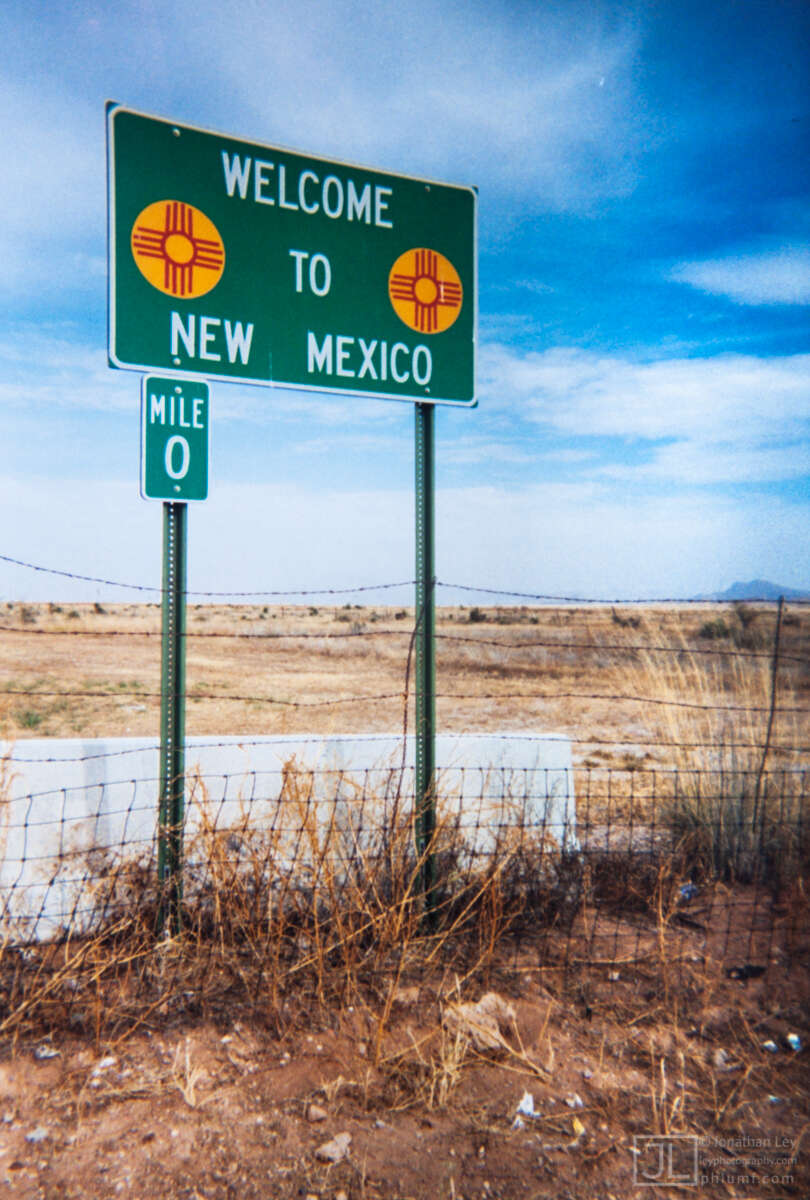I had 4.5 liters of water, 6 days of food and 1 thought on my mind – Antelope Wells. The way ahead was mostly flat, and the fastest route was paved, but at the end was the actual end, and to get there I would have walked barefoot on lava. My poles bounced off the hard asphalt, I had no companions but the speeding cars… and what did they know? None of anything mattered, just the automatic pilot in my head.
Most highways were un-inspiring to the pedestrian, the highway south of Silver City was no different. I looked for little details on the map for which to shoot – baby steps. There was a mining operation ahead, and a railroad track that crossed the road… not much more than that until the next intersection. I started timing my mile-per-mile pace with my digital watch. I calculated that I was walking about 3.95 miles per hour, approximately. At that pace, I could afford to take a lot of breaks. I sat on the gravel shoulder of the road, one break every mile… no, every two miles… I was ignored by the speeding vehicles, and ignoring them just the same. I wondered it they realized they were driving the CDT.
I reached the mining operation. It was consuming the mountains along the divide to my right – eating the mountains to fund the human cause. “Brilliant”, I said, just like the Brits said it, when something wasn’t really brilliant at all. Five more miles to the turn! I let out occasional vocal bursts – it was cheap entertainment, I never knew what was going to come out of my mouth next. Sometimes I yelled like an ogre, other times I laughed or howled. What was the difference? No matter what I said, my feet still took me forward, on the road, at 3.95 miles per hour.
I reached my turn and raised my fist in the air, “Woohoo!”. There was one less thing ahead, one more behind. The trail was becoming “graspable”. My new path was another road, Separ Road, but it was dirt and there was little traffic. It was 30 more miles to Separ… another “noplace” where two roads intersected, probably named by some cartographer who didn’t like the look of so much empty space on a map.

I walked a few miles down the road. The surrounding land was a patchwork of private and public land. I wasn’t sure where any of the boundaries had been drawn, it all looked the same to me. I pulled off the road, under some big trees, in what I thought was probably public property… maybe. It didn’t matter, there was no traffic, and nobody could see me. It was nearly dark.
One truck passed on the road – the only truck I’d even seen on the road. I crouched down, hoping to avoid any detection or confrontation. The truck slowed down, stopped, and then backed up. I couldn’t believe it. How in the world had they seen me? Hundreds of cars had passed me earlier in the day, and not one of them had noticed me. Then, in the only place it somewhat mattered, I had to “deal” with somebody. I put forward my best to smile and wave as two men got out and slammed their doors. “How ya doin’ here?”, one of them asked, not really interested in “how” I was doing, but rather in “what” I was doing. “I’m walking… on my way to the border, I just needed to sleep somewhere.” It was about as succinct as I could make it. “I plan to move-on at first light”, I continued immediately, “uh, this isn’t private property is it?” The man owned all the surrounding land, but I’d said a magic word and piqued his interest, “you’re walking where?”, he asked. After I explained my story, everything was ok. He told me there was a better place to camp about 200 yards away, but I’d already stopped hiking, and I wasn’t going anywhere unless forced. Among other things, they told me, “be careful what water you drink, cause some of it’s poisoned for the coyotes”. I wondered how people knew that only coyotes would drink the poisoned water, but I was certain they’d figured something out… or, more likely, that they just didn’t really care. People treated coyotes like spiders – killed them on sight whether they really posed a threat or not.
At 3AM, I heard a rustle in the bushes behind my head. I was in a tired state of mind where any activity was too much. I forced myself to flip a light on the bushes. “Come on…”, I whispered, “let’s get this over with so I can go back to sleep…”. A few seconds later, I saw the culprit. An unmistakable fuzzy white stripe swayed in the moonlight – a skunk was headed right for me. I sat up and involuntarily made a panic sound like “WhoooaaaA!”. I would have rather been woken by a bear. The skunk was one animal that had my pepper spray beat. I had a brief vision of walking to the border, covered in skunk spray… a much more revolting odor than the human stench I already wore. Luckily, the skunk saw me before it got too close, before it felt threatened. It turned around and scampered off. I thought about it… I’d seen plenty of skunks in my life, but they’d all been flattened on country roads. It was the first skunk I’d ever seen alive in the wild… going about its business.
I reached another windmill early in the morning. It seemed that every windmill had a unique setup. That one had one large holding tank with walls about 6 feet high. A pipe led from the tank to a rectangular metal watering trough a few yard away. The trough had an “outlet pipe” that led a few more yards to some mud. The only standard things were the windmills themselves, all stamped with the same logo – Aeromotor Chicago. The sky was cloudy and the wind was blowing – perfect conditions as far as I was concerned. I filled a few liters and hit the road again.
A large vehicle was slowly following me, about a mile behind, matching my pace. I took a break and let it catch up. It seemed like a good excuse for a break. It was a road grader – a behemoth truck with a blade angled to scrape the surface of the road. It was all covered with peeling yellow paint. The man inside was as interested to see me as I was to see him. It seemed that people were always interested to meet other people when they were in odd places. The man told me that he’d seen others walking the road in years past, my presence seemed to confirm to him that it hadn’t been a fluke or a dreamt-up memory. Yup, I was indeed walking to Mexico… it didn’t seem too far anymore. We were actually on the divide at that very moment – barely even a hill. To the man, that’s all it probably was – a hill, not much unlike any other. But to me, it was all one hill, one long uninterrupted ridge. I’d seen almost 3000 miles of it, I knew.
The road continued its slow wind the rest of the day. There were few trees anymore, just yuccas, century plants, a few cactus, and a lot of un-nameable bushes. The flatness was only interrupted by stark island peaks scattered on the horizon. The divide quietly drifted to the east, I knew I would still have one more chance to say good-bye up ahead.
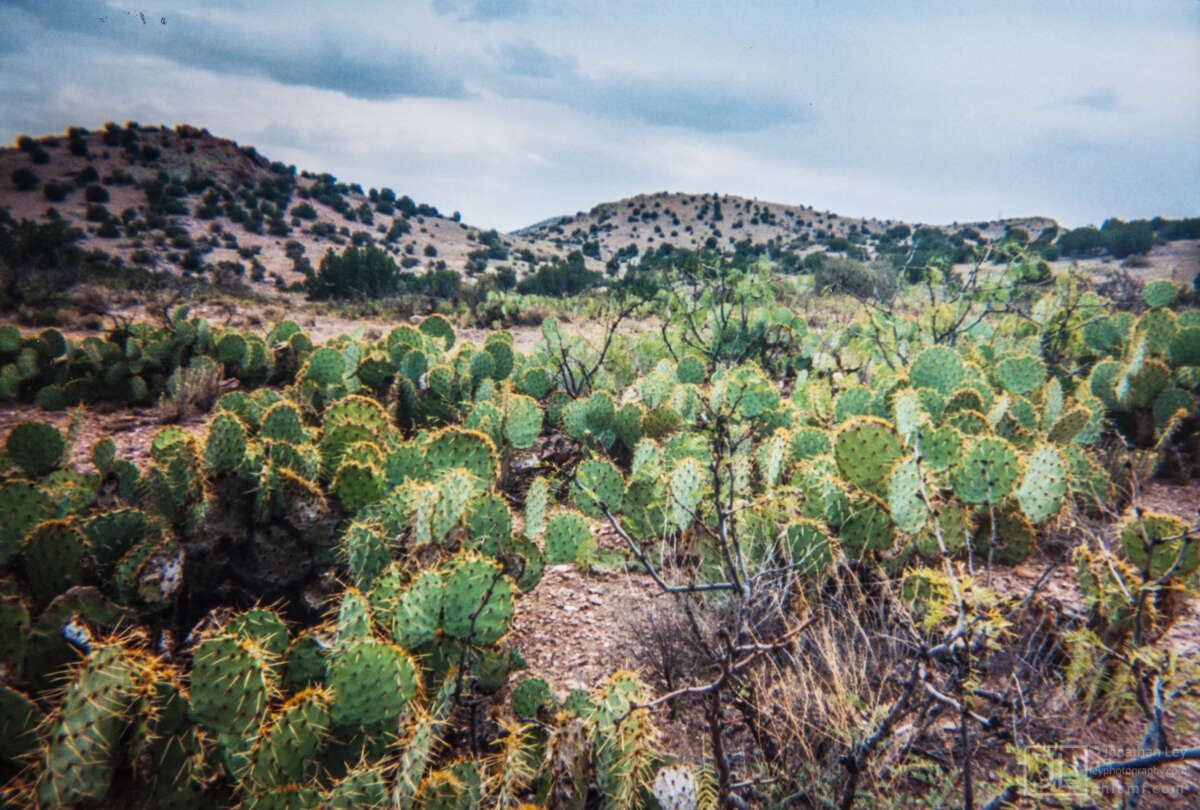
Late in the day, I took a break on another random spot of rock and sand. I was popping crackers into my mouth, staring at nothing, dead ahead, when I was startled by another rustle in the bushes. A dog was crouching toward me. He was a mid-sized brown and white mutt, belly low to the ground and tail between the legs, “I’m not going to hurt you”, his demeanor said. I didn’t stand up, I just turned my tired stare toward the dog. He approached very close, and pushed his head under my arm… no doubt getting a cheap high off my stink. He started rubbing against me, as if to prove to himself that I wasn’t a ghost. I tried my best to guess his intentions. “Are you lost?”, I asked. He just looked at me. “Are you hungry?… thirsty?”. He started to wag his tail, only in recognition of a friendly voice. I offered him a cracker and he timidly accepted. I wanted to bring him with me… every long hike needed at least one “dog story”. I gave him a couple more crackers, then I stood up and shouldered my pack. All of a sudden, the dog freaked out. He started barking and slowly backed off, reacting as if I’d just transformed into an alien beast. No manner of coaxing changed his temperament, and I gave up and continued down the road. The dog disappeared back to his old life, unable to tell anyone about his strange desert encounter – about the alien who’d given him crackers.
I made camp in a tiny arroyo – a little trough of sand flattened by some torrential rainstorm long forgotten. I looked up at the stars, “I’m gonna miss you”, I told them.
The clouds thickened overnight. The morning brought no sun, only an indirect grey. The road straightened, and a highway came into view ahead. It was a progression of white semi’s – small rectangles rolling over the flatness from horizon to horizon. Separ. A steady rain began to fall just before I reached the highway. I spotted a truck-stop on the other side under a big sign that read, “Continental Divide”. Perfect. I reached the shelter of a dripping wet roof. I set down my pack and went inside.
The truck stop was filled with a thousand types of useless kitsch. Indian dolls, painted paperweights, plastic cowboy boot ornaments… all of it made by automatons in some factory in Taiwan. Who bought this stuff? I wondered. I bought a bag of potato chips and a coca cola and waited for the rain to pass. An hour later, I gave up. The people in the store were only conversing in one-word sentences – they might as well have been computer terminals, “place money here”. The truck stop was surrounded by boarded-up failed businesses, and nondescript junk that was being “stored” by people who’d never again touch it. “Do you know where the dirt road heads south from here?”, I asked. The people behind the counter looked at me blankly – “does not compute.” They knew only the highway and the prices of the trinkets – next gas? 40 miles.
South of Separ was a wasteland. Acres of barren hard-packed dirt and rusted barbed-wire told of a place that had either been over-grazed or used as a giant corral. Every plant had either been chewed or stomped. It wasn’t a total ecological disaster, there was still a lot of healthy land in the surrounding flatness, it was mostly a monument to the cow, and if not the cow, then what? the sheep? We were so predictable.
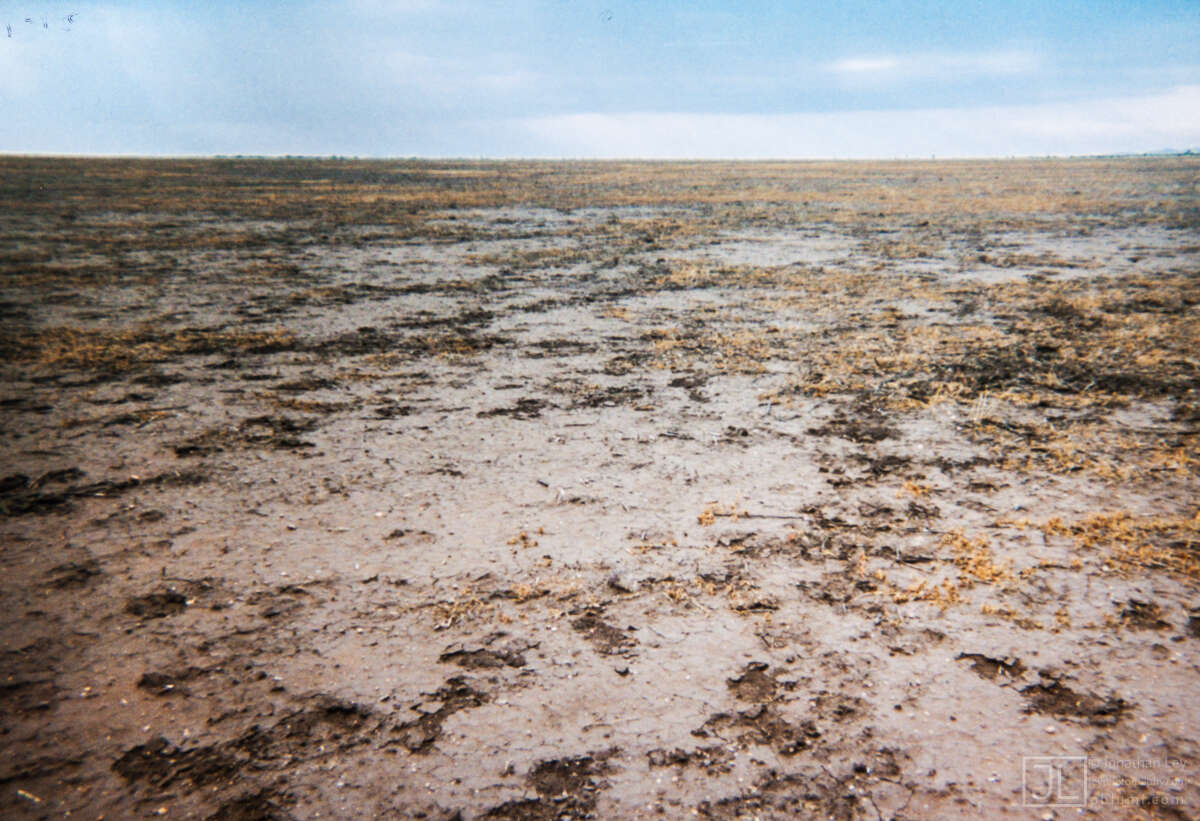
A white SUV sped toward me over the mud. The vehicle was crowned with a rack of flashing lights and painted on the side, “Border Patrol”. A uniformed man leaned out the window, “Where do you live?”, he asked. I didn’t know what to answer… I figured that my usual joke, “right here” might get me into trouble. I thought about my driver’s license, “Uh, Seattle?”. My American accent was all he really needed to hear. “You look out, a smuggler has been sighted in the area.”, he warned. I wasn’t sure why that might concern me, but agreed it was a serious matter, “Ok…”, I told him. He drove off. click to enlarge
I walked a few miles south along the old dirt road, then turned southeast through the yucca and brown grass. Lightning lit up the horizon to the southwest, it looked like I would miss the heart of the storm though, it was just a light show for me. I spotted a badger, running through the bushes. My natural dog-instinct to ‘chase it’ took over. The badger wasn’t very fast, and I was soon nearly on top of him. He ducked into a hole, but it wasn’t his hole, and he didn’t quite fit. His little grey butt stuck out the back of the hole, while his front claws did their best to scoop out more dirt. I lightly poked him in the backside, “busted”, I said. The poor thing was probably terrified, but I figured a bit wiser for the experience.
A few minutes later, I passed a desert tortoise… slowly crawling across a stretch of over-grazed mud. I had heard there were indeed tortoises in the area, but it was a hard thing to believe. It seemed such an unlikely match to the landscape. The tortoise was about 10 inches long and 6 inches wide. He looked like something out of Jim Henson’s creature shop – a design far more bizarre than required for survival. He’d grown to a decent size, I guessed he’d be all-right.

I reached another asphalt road. It was the last road. It headed due south, all the way to the border. A mile post sign read 8. I started walking. In a few miles I crossed the divide for the last time. It didn’t even look like a hill there… just the top of a long slope. The divide still had a long way to go, it still had whole ranges of mountains to traverse. Mountains even more wild and spectacular than those I’d discovered on my little trip. I gave a salute and continued down the road. As it got dark, I pulled into the bushes. It was time to rest for a spell.
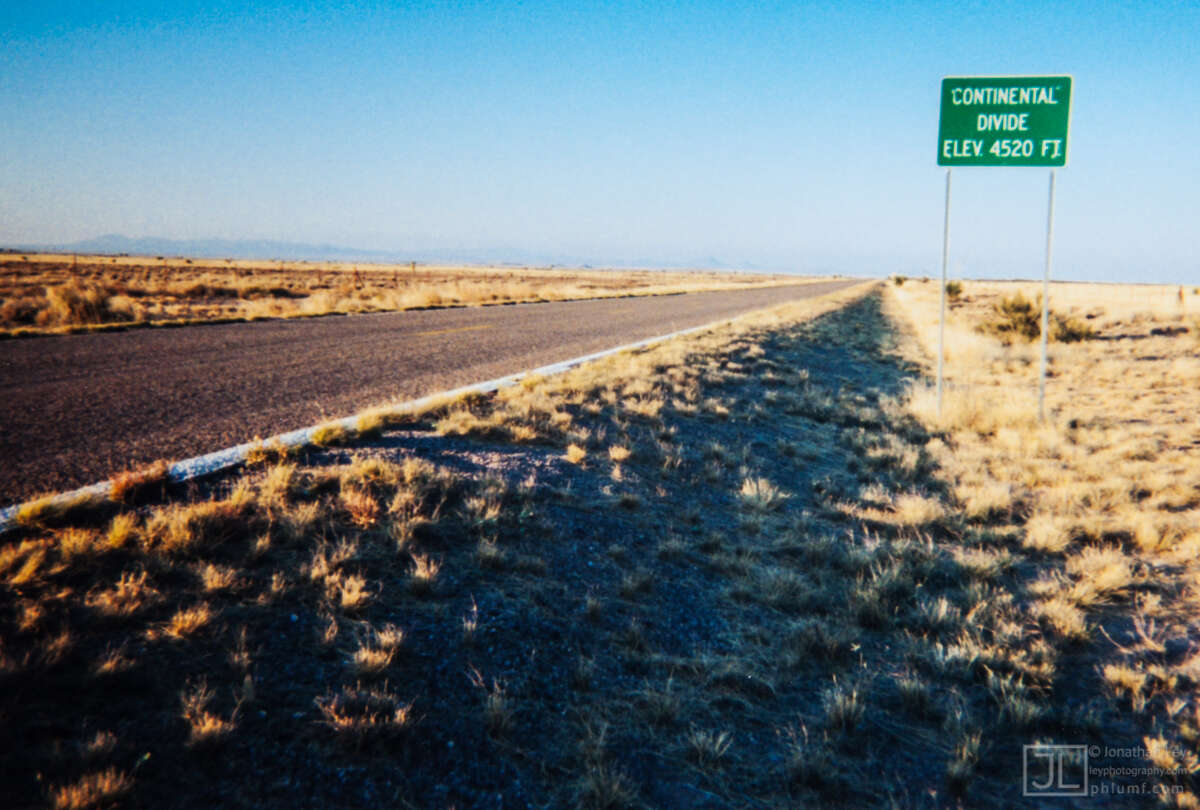
In a couple hours, I reached Hachita – around 200 people living at a crossroad in the middle of nowhere. As near as I could tell, Hachita consisted of a cafe, a bar, a post office, a church and a couple blocks of homes. I got a couple breakfast burritos in the Cafe then kept going… 50 more miles of nothing to the border.

I was still on the road. I didn’t enjoy walking on asphalt, but at least it was quick… still going 3.95mph. The sky had cleared up, and the sun made a warm day… probably the warmest it had been since Wyoming. I took breaks under the poor shade of tall yucca plants. The yuccas were big balls of palm-like spikes growing on stiff stalks covered with a grassy fur. The yuccas tended to grow about 12 feet high, then fell over – victims of their own success. I looked up at one yucca and noticed a grasshopper, impaled on the tip of one of the spikes. It was a funeral on a spit, courtesy of shrike no doubt.
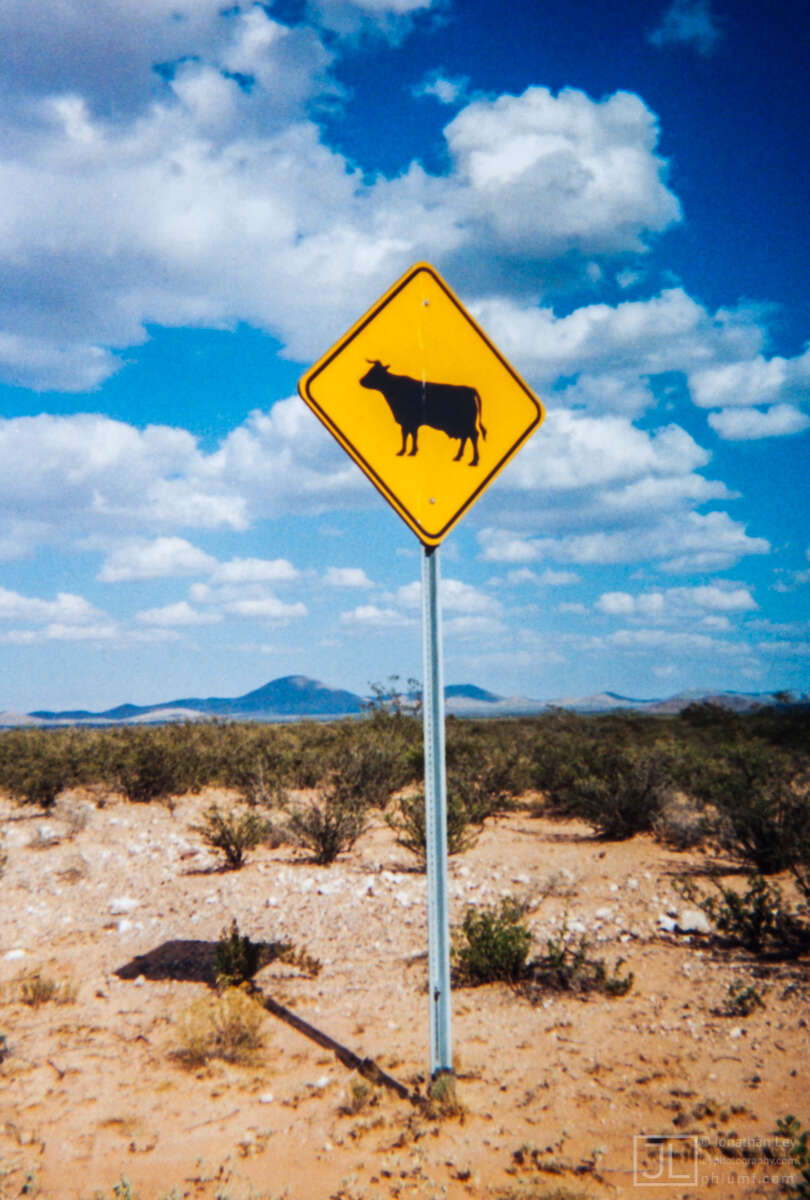
The grasshoppers were everywhere. Their bodies were colored brown and grey, but decorated with striking red, blue and yellow neon racing stripes. They looked almost like plastic robotic toys. The larger ones were a good 4-5 inches long, and as wide as a swollen thumb. They couldn’t jump, much less fly, they crawled moving one leg at a time as if burdened by their own hulking bodies. The smaller ones, however, hopped and flew all across the land 10 feet at a time, their wings clacked and buzzed as they went. I guessed the smaller ones were males, engaged in stiff competition for the larger females… but I had no way to be sure. At least they were something to admire as I continued down the road
The road was routed along a flat valley in-between two parallel ridges of stark peaks to either side. To the west was the divide and the Animas Mountains, to the east and ahead were the Hatchets. Big Hatchet Peak loomed directly ahead. It was a giant ruffled pyramid that grew a little bigger with each step. And with each step, I became more determined to climb it. It would be my one last prize.
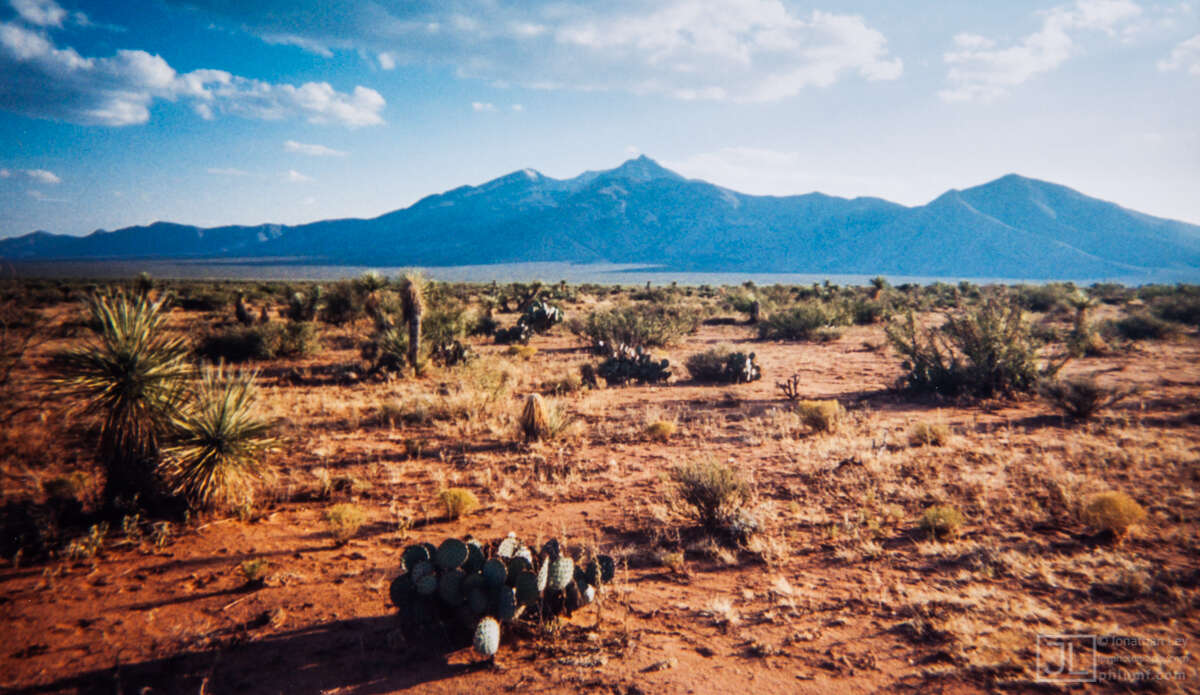
I stopped for a water refill and a meal at a windmill, then headed off the road, toward the peak. I had picked up a couple detailed maps of Big Hatchet Peak back in Silver City. According to the maps, the peak was riddled with a maze of cliffs that made any approach difficult. I’d decided on an approach that took me up a canyon to the northwest of the peak – Chaney Canyon. It appeared steep, but not impassable. As evening approached, I reached the flank of Big Hatchet Peak – a skirt of land that slowly rose over the surrounding landscape. The setting sun lit up a couple minor peaks to the west. The only trees were a couple clumps of cottonwoods in the distance, supported by over-flowing windmills. It was still and quiet out there… except for the fighter jets.
The area was used by some distant military base for combat training. Every now and then, the silence was crushed by pair of military jets that roared between the mountains. The flights went into the late evening, when the planes were only visible from their red-hot exhausts. I figured that if there ever was world peace, it wouldn’t spell the end of fighter jets… the people that flew them would find some excuse to keep them, because they appeared to be too much fun to just quit.
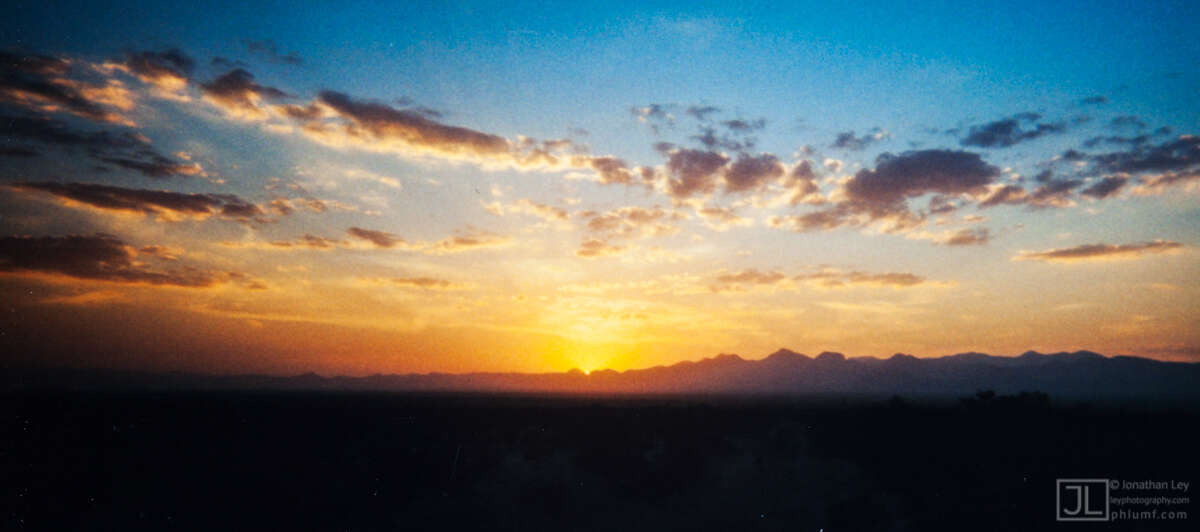
In the morning, I continued my traverse around Big Hatchet Peak. The cacti and yucca were getting thicker, but I managed to find a clear winding path that kept me just out of their reaches. A bigger problem was crossing the small but steep-walled arroyos that emanated from the top of the peak. The walls of the arroyos were made of loose rocky soil just waiting to get washed away. I managed to execute controlled falls into the arroyos and then clamored wildly up the rocks on the other side – the large rocks rolled down as fast as I could step over them. As the canyon got steeper, the sharp plants got thicker still. Additionally, the mountainside supported a forest of scrappy evergreen trees that grew low and thick. Pretty soon, I was stepping through clumps of thorny bushes in order to get to small clear paths which ended abruptly. As the wall got steeper and narrower, my options became limited. To make things worse, I couldn’t even see the way ahead because it led directly to the sun. All I could make out were steep shaded cliffs on either side of me. I wasn’t sure if there was there another wall in front. I looked at my map again… it had to be the right spot… I looked back and thought of turning around. There was no way, I was already too far up the mountain, I had too much invested. It was an exercise in determination, in a way it was almost refreshing to have the challenge. I just shook my head kept my focus. “Just one more peak”, I kept telling myself.
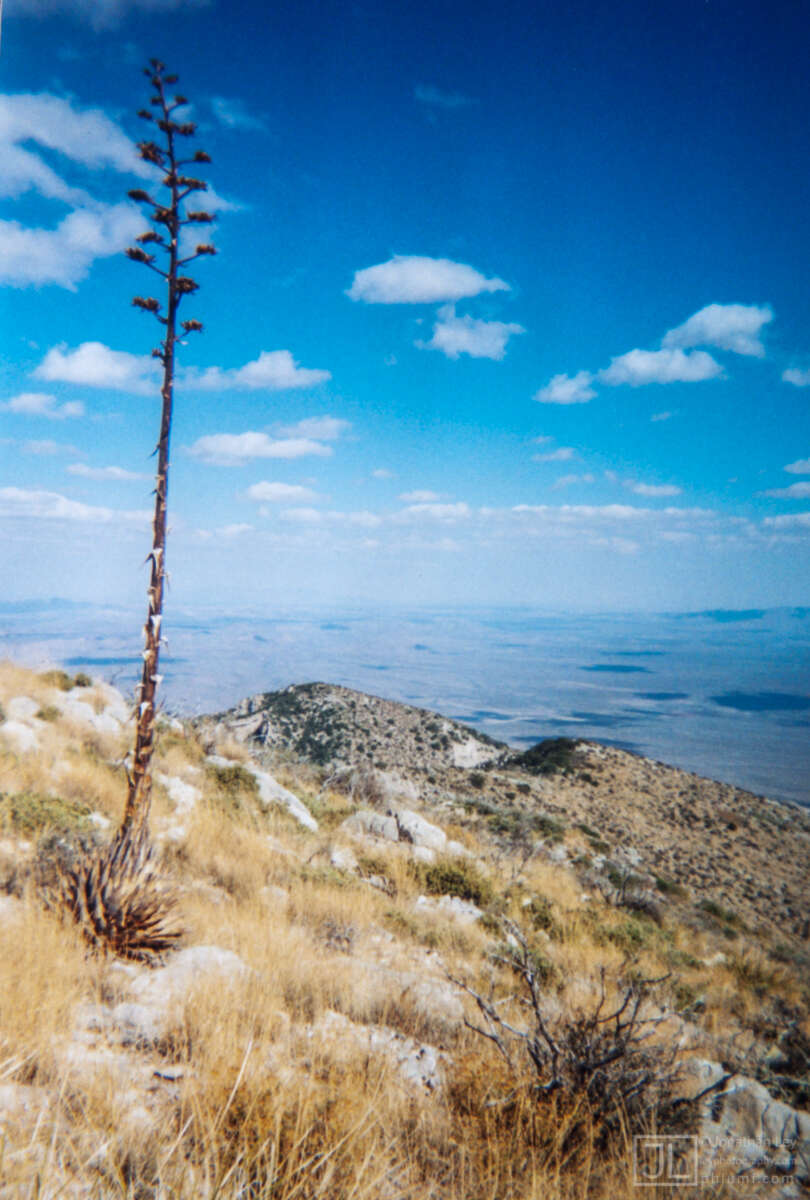
The trees got thicker. On more than one occasion, I ducked around a low-hanging branch only to impale myself on a stiff yucca. Someone had told me they were of a variety called “Spanish bayonets”, and I found out why. The stiff leaves shot straight out like a bouquet of sharpened knifes, there was no way to push them aside. The tips of the plants penetrated 1/2 an inch into my legs or hands before I was even able to notice I’d been stabbed. Sometimes, the only way forward was over the top of prickly pears. The sharp spikes went right through the fabric of my shoes, then lodged and broke off in the flesh of my feet. The terrain was so steep and the vegetation so thick and thorny that I had trouble finding places to rest and lick my wounds. I was making such slow progress that I didn’t want to stop anyway. There seemed to be no top to the peak. Then I ran into a wall.
By then, the sun had moved enough to reveal the terrain ahead. I was only a hundred feet from the top of the canyon. The way ahead was a series of 10-foot high vertical walls, separated by steep narrow ledges covered in cactus. Once again, I looked back… it was a long way, straight down. I pulled myself over the first cliff, then walked over and through the cover of cactus along the top. The soil crumbled underfoot and careened down the wall. I had the feeling nobody had ever walked there, and if had fallen, I would have been seriously screwed. I concentrated on every step, always keeping as many solid points of contact as possible. The ledge led to another wall, then another ledge and another wall. I just didn’t think about any other option – I HAD to go forward. Finally, I crawled over the last wall, over the top of the canyon.
I had hoped the ridge would be less vegetated as it was exposed to more harsh direct sunlight. There were fewer trees, but they’d been replaced by spindly bushes whose branches ended in stiff sharp thorns. The rocks between them were mostly loose and difficult to maneuver around. It just wasn’t getting any easier. I slowly picked my way through the rocks, through the thorns, up the still-steep hill, and finally reached the summit just after noon. It had taken me about 5 hours to go 4 miles. There was a small clearing at the top, and of course, a small man-made pile of rocks. Under the rocks, somebody had stashed a glass jar that held a bunch of papers. The summit register, it was old and fairly empty. The last entry had been dated August 8. It seemed that only about a half-dozen people bothered to climb the mountain each year. The top of Big Hatchet Peak was 8356ft, 4000 feet above the road. The view was rather impressive… immediately to the west of the summit, a sheer wall dropped almost 1500 vertical feet. To the distance, a series of similarly cactus-covered peaks, many of them not even named, popped out of the plain like islands from a sea. I sat down in the clearing, it was my first break of the day. At least, I kept reminding myself, it was all down-hill from there. I looked over at a century plant near the top and saw that it was covered in ladybugs. Hundreds of them crawled on top of each other. Mountaintops were perfect meeting places for such wandering loner insects. It was one of those bizarre displays that reminded me I was indeed somewhere special.

I couldn’t afford to stop for very long though. It was a long way down the mountain, and I had no idea where the next water was. I picked my way through more rocks, the trail of thorns continued. About a half-mile south of the summit, I encountered a faded footpath – It was the the route that the “better-informed” took to the top of the mountain. Unfortunately, the footpath headed down a canyon to the northeast, which was not where I needed to go. Still, I was able to follow it for about a mile before I had to turn off. I realized that the descent from the top of Big Hatchet wasn’t all down-hill… in order to avoid cliffs, I had to climb up and over a series of ridges. The thorns got even thicker. I crested the top of one ridge and saw two solid miles of interlacing thorny branches, and steep loose rocks. There was no escape from them, no way around. I let out a sigh and gave myself to the land. I’d have time to heal later. I didn’t know what the bushes were called, so I made up names for them – the “Spiny thornbush”, “Jonathan’s flesh-ripper” and the “impailer-plant”. I found there were many more small cliffs than those shown on the map. The map only had a contour resolution of 10 feet, and many of the cliffs were slightly smaller. They were negotiable, but they slowed me down. After wading though 5 miles of brambles, and up and down countless rocky walls and ridges, I finally reached an old dirt road.
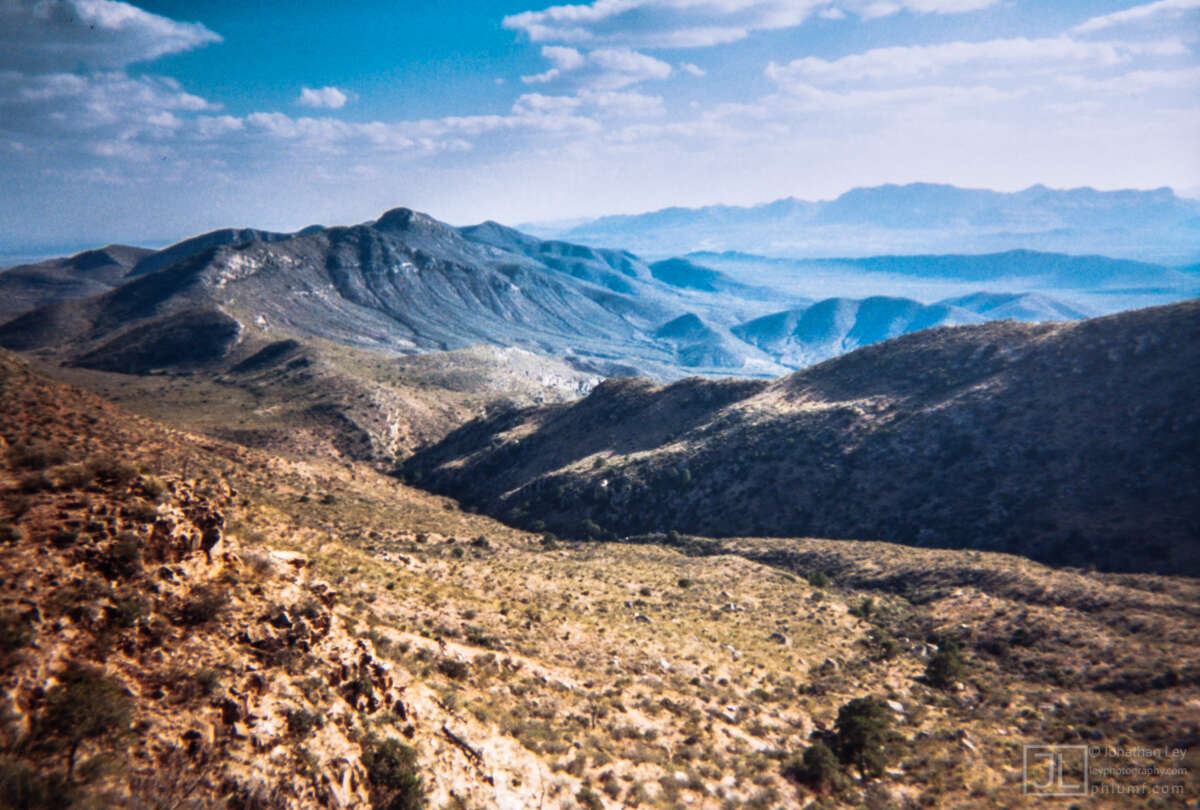
I was happy to be free of the thorns, but I had another problem – I was out of water and thirsty. A mile down the road I passed next to something called “Big Tank”, which as I suspected, was nothing more than warm muddy water laced with cowshit. It was absolutely putrid, I decided I’d rather go thirsty than have any part of it. There was a windmill marked on my map a couple miles ahead… I knew my map had last been edited in 1982, but I had some hope the windmill was still there.
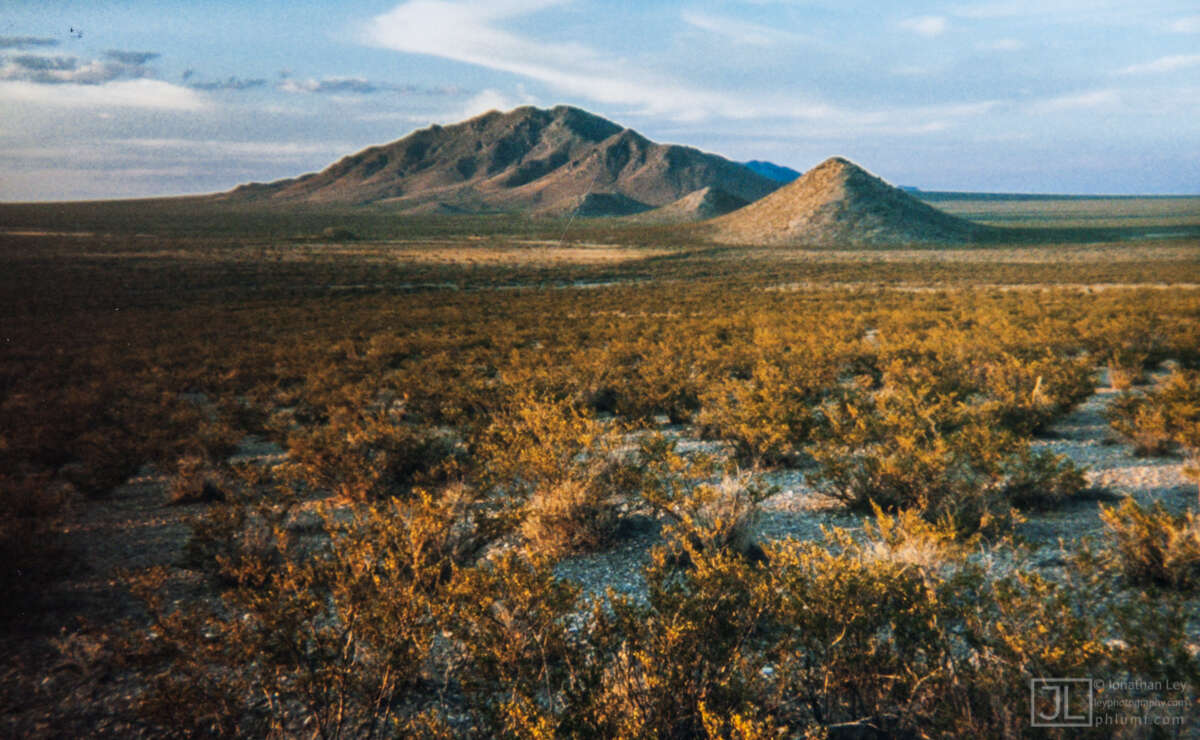
I reached the windmill at dusk. All that remained of it was a broken tower and an an abandoned ranch-house – somebody’s failed dream, consumed by the harsh desert. I was just able to make out another tower in the twilight, about a half-mile south. It was my only hope for water, it would soon be too dark to see anything.
The tower had no windmill, but it did have an electric pump. There was water stored in a high-walled tank. A low-walled concrete cattle trough was nearby. Water was spilling over the edge of the trough, and the trough had turned into an island, surrounded on all sides by a thick pool of mud. Still, there seemed to be fresh water coming out the trough. It seemed worth a closer look. I took one tentative step into the mud and sank up to my knee. I made a hasty decision and just said screw it. I walked through the thick mud to trough. There was a float mechanism in the trough, intended to shut the pump off when the water reached a certain level. It appeared to broken. Water was gushing out a hole in the pipe that ran along the bottom of the trough. It was impossible to get any fresh water from the thing. Great. I walked back through the mud and filtered water from the high-walled holding tank. By then, it was dark, my legs were caked in a half-inch of thick grey clayish mud, and the wind was picking up. I did my best to clean my legs, and crawled under a bush in a futile attempt to avoid the wind.
As the evening wore on, the wind intensified. Before long, it developed into a full-fledged wind-storm. I huddled in my sleeping bag as the sandy soil whipped into my face. It was miserable. I managed to get a couple hours of what might have been called sleep. By 3am, I’d had enough. I packed my things together and started walking. It was time to get the thing over with.
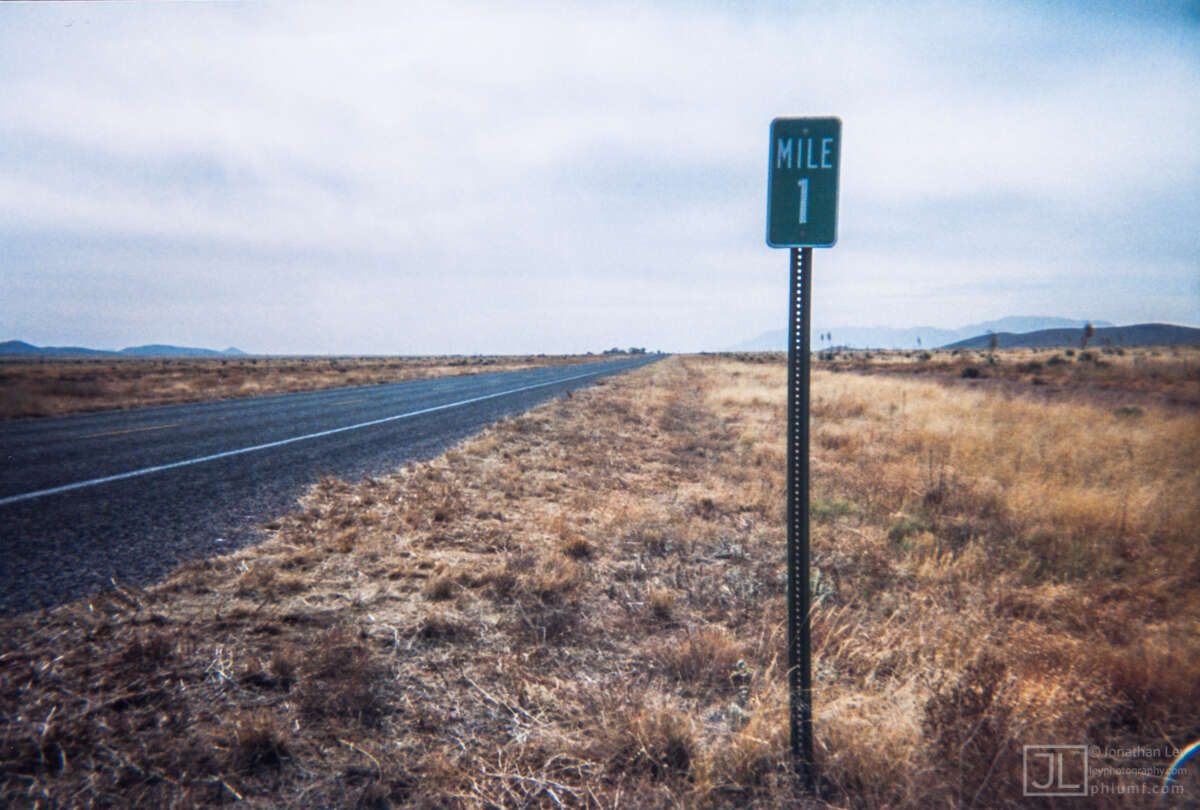
I walked through the darkness, down the dirt road, back to the paved road and turned south. Mile 17, the post read. I watched the miles count down, one by one. The wind stopped. The sun rose. Mile 3,2,1… There it was, Antelope Wells – a couple lonely buildings next to a barbed-wire fence that was the border. I got to the little bench outside the building and set down my pack… for the last time. I didn’t scream or cry, or shout. I just sat down on the bench and looked forward.
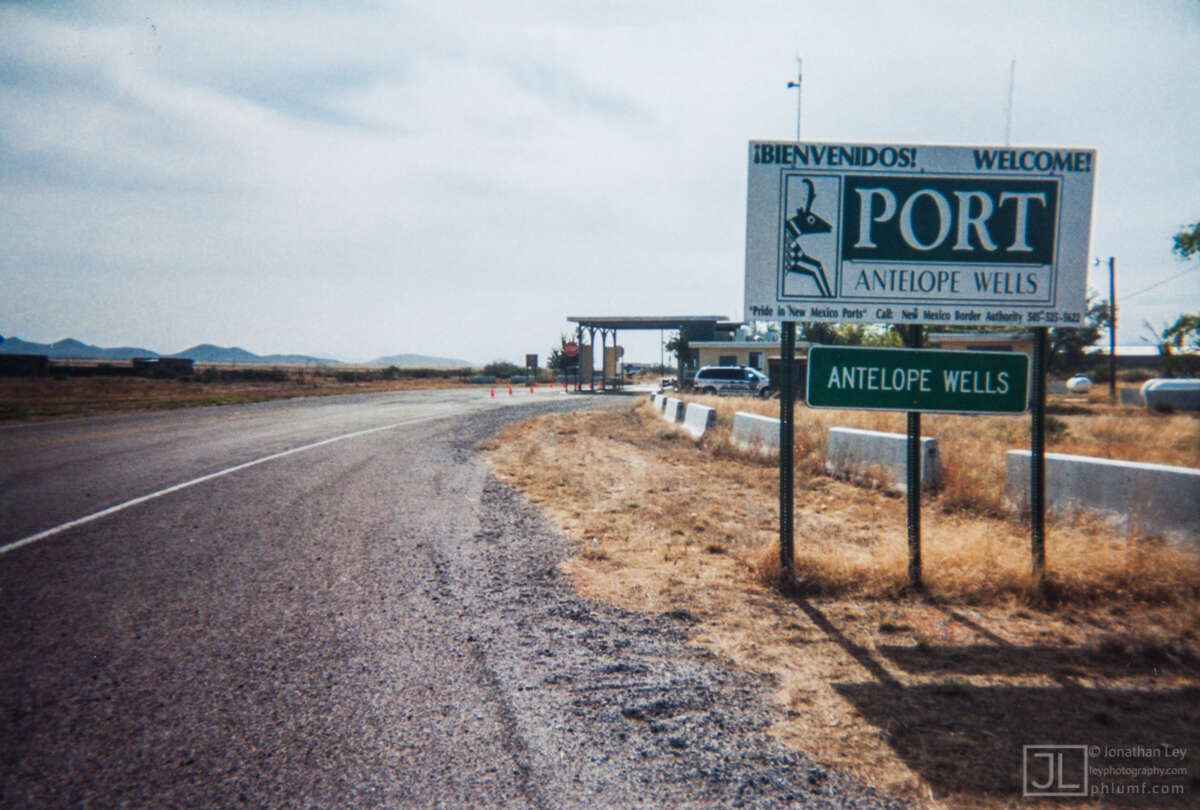
I hadn’t really prepared for the end. I was sorry the trip was over, but happy about it all the same. The CDT had been a home no doubt, but like so many homes, after a while it had become too comfortable, there were other homes to discover, other trails to hike, other people to be. Time pushed me like a relentless coach, “Come’on, let’s keep it moving now!” And whichever direction it pushed, it was the same direction – forward.
I looked at the sign just on the other side of the border – Janos Mexico 55km. I had enough food to get there… maybe someday, I thought, I would.
